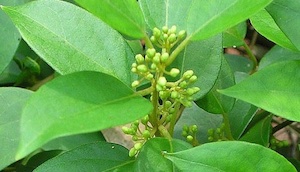The Gurmar plant, a perennial climber native to India, is remarkable for its ornate structure. Its roots stretch deep into the ground, absorbing nutrients from rich soils. Thin, flexible stems, often sprawling over larger plants, reach lengths of 3 meters. The leaves, ovoid and smooth, showcase a vibrant green hue, hosting small yellow flowers during bloom. Each flower develops into a slender follicle, encapsulating the plant’s seeds. The entirety of this intricate design allows the plant to thrive in diverse environments, its physical characteristics a testament to its adaptability and survival strategies.
Gudmar, an Ayurvedic herb has botanical name Gymnema sylvestre, hosts an array of health benefits. This plant is most renowned for its antidiabetic properties; the leaves contain gymnemic acids, compounds that can help regulate blood sugar levels by decreasing glucose absorption in the intestine. Besides this, Gudmar is touted for its anti-inflammatory, antiviral, and antimicrobial attributes, helping combat various infections. It also possesses potent antioxidant properties, which can reduce oxidative stress in the body. Furthermore, it aids in weight management, as it suppresses sweet taste receptors, potentially reducing sugar cravings. Lastly, preliminary studies suggest potential benefits in treating digestive and respiratory disorders.
Gudmar or gymnema for diabetes
Gudmar is often referred to as “sugar destroyer” because of its remarkable potential in diabetes management. The plant’s leaves are loaded with active compounds like gymnemic acids, which have been linked to significant antidiabetic effects.
Research reveals that these compounds of gymnema help regulate blood glucose levels by inhibiting glucose absorption in the intestines and promoting insulin production in the pancreas. Furthermore, they are thought to assist in regenerating islet cells, crucial for insulin production in the body. This dual-action mechanism can help maintain a balanced blood sugar level, making it an integral part of many traditional diabetes treatments.
Additionally, Gudmar offers unique benefits, such as the temporary suppression of sweet taste sensations. This characteristic may contribute to reducing sugar cravings, indirectly assisting in weight management, an important aspect of diabetes care.
When this herb is used along with other herbs like Jamun Fruit, haritaki, amla, vijaysar and fenugreek seeds, it effectively helps in the management of blood sugar levels. Moolika Ayurveda Diasol Capsules contain all these herbs and it is the best ayurvedic medicine for diabetes.
Gudmar or Gurmar for Weight Loss
Known for its anti-diabetic properties, Gudmar has a distinctive impact on weight management as well. This plant’s active compounds, such as gymnemic acids, are thought to influence weight control mechanisms in the body.
One way this is achieved is through the inhibition of sweet taste receptors. When the leaves are consumed, they can suppress the activation of these receptors, potentially decreasing the desire for sweet foods and, therefore, reducing overall caloric intake.
Gymnema also impacts glucose metabolism. It slows down the absorption of sugar in the bloodstream, which can lead to a reduced sense of hunger and cravings. In effect, it might reduce the overall calorie intake and support weight loss efforts.
Moreover, there’s an impact on fat absorption and metabolism. Some studies suggest that the plant can inhibit the absorption of fats and promote their metabolism, further assisting in weight reduction.
While more research is needed to fully understand these mechanisms, preliminary evidence suggests promising potential for this plant in weight management. As with any weight loss strategy, it should be complemented with a balanced diet and regular exercise for optimal results.
Gudmar for Liver Health
The therapeutic potential of Gudmar, also known as Gymnema sylvestre, extends beyond managing blood sugar levels; emerging research highlights its positive influence on liver health. The liver, a critical organ for detoxification and metabolism, can suffer from various diseases such as fatty liver, hepatitis, and liver cirrhosis. Gymnema has demonstrated hepatoprotective properties, potentially safeguarding this organ from damage.
A prominent constituent of gymnema, gymnemic acid, exhibits anti-inflammatory and antioxidative properties. These attributes can help mitigate liver inflammation and protect against oxidative stress, a major contributor to liver disease progression. Oxidative stress, which results from an imbalance between the production of free radicals and the body’s ability to counteract their harmful effects, can lead to cellular damage, particularly in the liver.
In addition, gymnema promotes liver health by potentially aiding in the management of lipid profiles. It may help reduce elevated levels of triglycerides and low-density lipoprotein cholesterol, often associated with non-alcoholic fatty liver disease (NAFLD), while boosting beneficial high-density lipoprotein cholesterol.
Moreover, animal studies have suggested that gymnema can attenuate fibrosis and cirrhosis, key features of advanced liver disease. However, human clinical trials are needed to further explore these findings.
Gudmar or Madhunashini in Ayurveda
Madhunashini, also known as Gudmar in Ayurveda, is revered for its medicinal properties. It’s commonly referred to as ‘sugar destroyer’ due to its potent anti-diabetic properties. Within Ayurveda, it is known to have a significant impact on the three Doshas – Vata, Pitta, and Kapha, mainly pacifying Kapha and Pitta doshas while potentially aggravating Vata when used excessively.
Delving into its Ayurvedic properties, Madhunashini’s Rasa (taste) is classified as Tikta (bitter) and Kashaya (astringent). Its Guna (quality) is Laghu (light) and Rooksha (dry), which helps it alleviate increased Kapha. Veerya, or potency, is Ushna (hot), suggesting it contains energy to process and transform substances in the body, counteracting excess Kapha and Pitta. Vipaka, the post-digestive effect, is Katu (pungent), which supports metabolism and digestion.
The extensive Ayurvedic uses of Madhunashini testify to its value in this ancient health system. It’s chiefly employed in the treatment of diabetes and hyperglycemia, thanks to its ability to inhibit glucose absorption. It’s also used in managing obesity due to its potential to curb sweet cravings. The plant is beneficial in dealing with various skin diseases due to its blood-purifying properties. It has also been found use in Ayurvedic remedies for indigestion, constipation, and liver disorders.
Despite its many uses, it’s essential to remember that the effects of Madhunashini can vary based on individual constitutions and the presence of other health conditions. As with any remedy, it should be used under proper guidance.
Reference:
Tiwari P., Ahmad K., Baig M.H. (2017). Gymnema Sylvestre for Diabetes: From Traditional Herb to Future’s Therapeutic. Current pharmaceutical design, 23(11), 1667–1676. https://doi.org/10.2174/1381612822666161221115327
Kumar, V., et al. (2020). “Effect of Gymnema sylvestre, Citrullus colocynthis and Artemisia absinthium on blood glucose and lipid profile in diabetic human.” Acta Poloniae Pharmaceutica, 77(4), 455–462.
Tiwarekar, V. and Rathod, V., 2019. Hepatoprotective activity of Gymnema sylvestre on Paracetamol-induced liver damage in rats. Pharmacognosy Research, 11(3), p.264.


